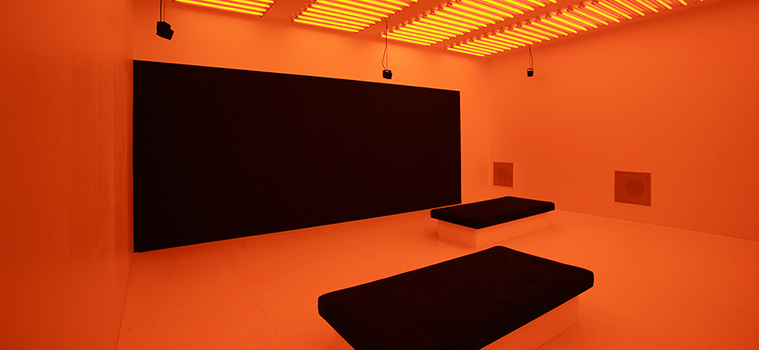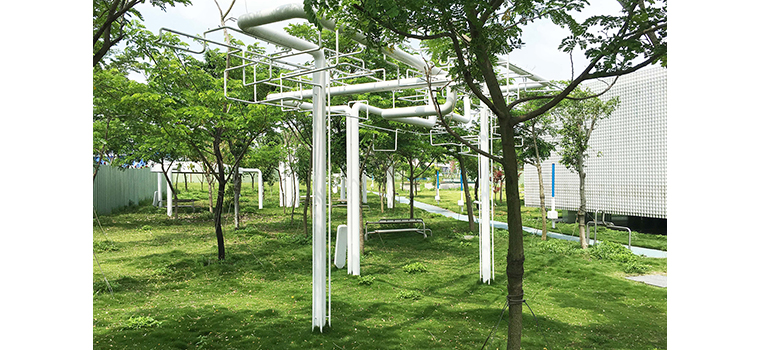Philippe Rahm hopes his latest exhibition will help inspire a new style of design.

Philippe Rahmís approach to architecture uses walls and floors covered with low-emissive materials and colors selected based on their ability to absorb or reflect light or heat. Photo by Adam Rzepka, Centre Pompidou
BY BILL PICTURE
Published: April, 2018
Philippe Rahm hopes his latest exhibition will help inspire a new style of design. His goal is to look beyond the austere minimalism of the modernist architects of the first half of the twentieth century, whose less-is-more ethic continues to inform contemporary architecture, and instead find environmental solutions in unexpected places.
With his The Anthropocene Style exhibition, on view at the San Francisco Art Institute through May 19, the Swiss-born, Paris-based architect challenges fellow designers to ignore predecessors’ beliefs that ornamentation is old-fashioned, and instead approach the drafting table with both the comfort of occupants and the health of the environment in mind. He calls it “meteorological design.”
“It’s a responsible and resilient design practice, rather than one that is purely stylistic,” said the show’s curator, Hesse McGraw, a principal partner at Kansas City architecture firm El Dorado. “Instead of designing physical spaces, Philippe is thinking of physiological space and its relationship to the environment.”
“It’s a shift for sure in terms of the perception of what architecture means, but it’s really quite subtle,” McGraw said. “It’s about materials, color, temperature—things we can touch and feel.”
Say what?!?!
To understand Rahm’s post-modernist “Anthropocene” style, it is important to consider the key role that industrialization played in the shaping of early twentieth century modernist architecture.
Before gas and electricity were readily available, tapestries and rugs were go-to methods for trapping heat and blocking the chill that radiated from cold walls and floors. Heavy curtains were used to keep out cold drafts that crept in through cracks around windows, and crystal chandeliers were used to illuminate otherwise dark rooms with refracted candlelight. But once the world was turned on to fossil fuels, these methods of dealing with the elements were deemed old-fashioned and shunned as purely decorative by the modernist architects who abandoned them in the name of progress. Why hang tapestries on the walls when “nice and toasty” is available at the turn of a dial?
“We forgot that these decorative elements also had a function,” he said. “They’re weren’t only for style.” A century later, reliance on fossil fuels is considered a key reason for climate change. Still, the modernist “white box” style continues to be architects’ default for “hip” and “now” in the postmodern era.
Sure, newer buildings are outfitted with energy-efficient lighting and climate control systems, but Rahm is advocating for reincorporating some of the pre-fossil fuel “ornamentation” to take advantage of its comfort-making function. His take on it is anything but old-fashioned, but its function is the same and will help dwellers reduce their carbon footprints by helping further reduce their reliance on less environmentally friendly mechanical systems.
He proposes allowing design choices to be guided by the properties of effusivity, emissivity, conductivity and reflectivity. For instance, walls or floors covered with low-emissive materials—meaning they don’t radiate cold or heat—like aluminum or rubber can help maintain a comfortable indoor temperature, and colors can be selected based on their ability to absorb or reflect light or heat.
Rahm calls a white plaster wall that serves little other purpose than delineating the boundaries of a space a “very twentieth century notion.” “We can’t afford to think like that anymore,” he said. Replacing that plain white plaster wall with a red rubber wall or an aluminum wall will likely sound pretty unusual to most people, but Rahm argues it’s really taking architecture back to its roots.
“Architecture is now very focused on the visible form or the solid element, like it’s sculpture,” he said. “For me, it’s always been about the space within. What’s the number one reason why we build buildings? Isn’t it to create an environment inside where the climate is better than the outside—where there’s more light, or it’s less cold or hot? If you understand that, then you have to consider that interior space and design the meteorology inside that space. That’s what I mean by ‘meteorological architecture.’”
Fostering endless possibilities
“I think what’s most exciting about Philippe’s work is the sense of what is possible,” McGraw said. “And it’s not gesture or speculation. It’s got real potency in the world.”
What McGraw is referring to is a 70-hectare parcel of land that Rahm is reimagining for one Taiwanese city. The Taichung JadeMeteo Park sits on parcel of land that was once an airport. Temperature, humidity, air quality and noise levels vary throughout the park, so Rahm’s challenge was to come up with ways to temper these natural and manmade elements and create comfortable outdoor spaces for people to enjoy.
A variety of trees was selected for each species’ ability to create shade, reflect the sun’s rays, produce a strong evaporation that will cool surrounding air, absorb moisture in the air to reduce humidity and absorb sound.
Artificial “climactic devices” were designed to complement the plantings. One kind of cooling device blows cool air chilled by an underground heat exchange, while another has a water-cooled surface that visitors can touch for a quick “aah” moment. Drying devices blow air dried by silicate gel, which absorbs moisture. Pollution mitigating devices blow filtered air into the park, and another device emits mosquito-repelling sound waves.
Rahm said a developer in search of an overtly green design may find a park full of trees a bit more satisfying on a greening level than, say, an aluminum wall. “It’s a kind of greenwashing,” he said. “If you’re designing a building and you want to highlight how green it is, you add some trees and ‘voila.’ Having trees is popular because they provide a narrative for sustainability. An aluminum wall isn’t quite as sexy, but I’m trying to go deeper into the problem.”
Rahm admits the Anthropocene style seems radical at first glance, but he’s confident that the logic behind his ideas will appeal to designers looking to incorporate new expressions of sustainability into their work.
“It’s very logical,” he said. “Ten years ago, this was very strange, but less so now. People are interested. But it’s challenging, I know, so a person has to come to the table with a deeper interest in sustainability or with a desire to do more.”
Philippe Rahm: The Anthropocene Style, co-presented by swissnex San Francisco, runs now through May 19 at the San Francisco Art Institute Chestnut Street Campus’ Walter and McBean Galleries. For more information, visit www.sfai.edu/exhibitions-public-events/detail/philippe-rahm-the-anthropocene-style.

Rahm is reimagining the future of Taichung JadeMeteo Park, a 70-hectare parcel of land in Taiwan that occupies the former location of an airport. Photo by Philippe Rahm architects

